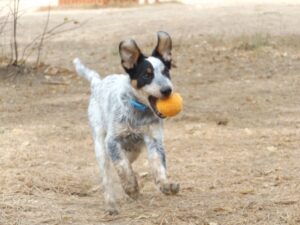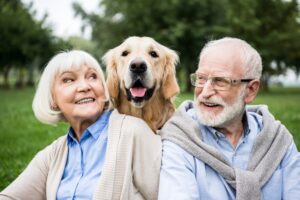You may be surprised at the differences between a puppy and a dog in adulthood if you’ve never owned one. You may be surprised to know your dog that many dogs as young as two months old still behave like a puppy. To ensure your dog is happy and healthy, it’s important to understand the different stages of life. The life stage of your dog will also affect the training techniques you use. Young dogs are more receptive to training and may need simpler or less complicated techniques. This chapter will discuss the characteristics and differences between the three stages in a dog’s lifespan: puppyhood, adulthood, and seniorhood.
Puppyhood

We all know that puppies can be so adorable. It is amazing to watch them grow up before your eyes. It is a wonderful experience to see your dog learn, grow and develop new skills. They can be very demanding, exhausting, and persistent. People who adopt a puppy must be patient during the first few months. Puppy learning begins immediately at birth. Between 2 and 4 months of age, puppies are most open to learning. As we have already mentioned, this is the best time to socialize your puppy to avoid fearfulness and skittishness in the future. Responsible dog owners must socialize their puppy from this age and start house training. Puppies need a lot of care, especially in the first few weeks after they arrive. Younger puppies excrete more often so it is important to take them outside frequently to help them learn to use the potty. They should be able to control their bladder and should eliminate between 5 and 8 times per day after the first few weeks.
You should ensure that your puppy is being fed high-quality puppy food with all the required nutrients. Human food can cause problems in the growth of your puppy’s bones, muscles, and other organs. From the time puppies are three months old, they need to be fed four meals per day. After that, you can feed them three meals per day. Another characteristic of puppies is their tendency to chew in a destructive way. Chewing strengthens teeth and provides mental stimulation in the dog world. It’s a puppy way to learn about the world and their environment. To prevent your dog from ruining your shoes, give them plenty of chew toys. It is also a good idea to teach your puppy what toys are appropriate for chewing on.
Adulthood/Adolescence

You might be thinking that the joy of puppyhood is over. Dogs can experience the same challenges as humans during their adolescence. Dogs also experience puberty. This is when they undergo a series of hormonal changes. Between the ages of 6 and 18 months, dogs reach adolescence. Your dog may experience mild pain during this period due to its growth spurts. Your dog will need a lot of chew toys during this time to ease the pressure on its jaws. This is also when their baby hair begins to fall and their adult hair starts growing in. This will lead to more hair loss. Between the eighth and the twelfth months of their adolescence, dogs reach sexual maturity. The majority of sexual maturity symptoms can be alleviated by spaying or neutering your dog prior to this time. This will prevent them from having their first heat.
Your female dog may be more excited to play with other male dogs. If your dog hasn’t been spayed by this point, it is important to supervise them when they are out and about. You may not be aware that they might get pregnant. Female dogs need to urinate more often as they grow up. Female dogs may also develop aggressive behaviors towards other female dogs. To prevent undesirable behaviors and actions, make sure that you continue to reinforce and train your dog’s good behavior. Adolescent dogs may also show aggressive behavior. Their bodies produce more testosterone, which leads to more extreme behavior. Male dogs begin to hold other dogs accountable for their duties based on the dog’s social hierarchy. This can lead to fights with other dogs. Male dogs need to be taught these feelings and responsibilities. This takes patience and training. Marking is another common problem among adolescent male dog breeds. You can prevent this by having your dog neutered before puberty, or with the proper training.
Boredom and anxiety are likely to be the cause of your adolescent’s destructive behavior. To prevent destructive behavior, make sure your dog does lots of exercises. To be calmer at home, they need lots of mental stimulation. Training your dog during their adolescence can be a great time. They are still learning- ing about people and animals. Your dog will be able to tell the difference between people they know and those they don’t. Be patient with your dog as you go through this crucial stage of life.
Seniorhood

Did you know that dogs who are older tend to be happier? Because they are used to their routines and have the ability to give all of their attention and affection, older dogs tend to be happier. Different breeds will reach seniorhood at different points in their lives, just like adolescence. However, it is important to be aware of when your dog will reach this age. This could mean that they need to make changes to their diet, exercise, nutrition, and overall health. Your veterinarian will be able to tell you when your dog should start making changes. Voice some common issues in senior dogs: Hip dysplasia is a condition that makes it difficult for dogs to run or walk. Depending on the severity of the condition, medication or surgery may be an option.
Orthopedic problems are a condition that results from normal wear and tear of the bones and joints in your dog’s body. This stage of life is where arthritis is most common in dogs.
Hypothyroidism is a condition that slows down your dog’s metabolism and can lead to obesity or heart disease. This condition can be easily diagnosed with a simple blood test, and managed with medication.
Eye problems: Older dogs can develop eye conditions such as cataracts or hamper vision, which can lead to blindness.
Cancer: This is a common condition that can affect any age of a dog, but it is more prevalent in older dogs.
Dogs can experience confusion as they age and have memory problems. Due to declining kidney and bladder function, they may have to use the toilet more often. There is a greater chance of cancers or infections in the reproductive organs if your dog has never been spayed or neutered. You can spot signs early by keeping an eye on your dog. Some of these issues can be treated with medication. These times are important for your dog. Don’t force any changes.
To prevent injury, pain, or further deterioration, you should avoid jumping and vigorous running. Your dog may become more independent as he/she gets older. Talk to your vet about the resources that you have to make your dog’s life easier. To help your dog live a normal life, you can make small adjustments to your home. This is the most important time in your dog’s life. There are differences between dog training and puppy training Most people have heard the expression, “You can’t teach an older dog new tricks.” However, this is not true. It is not easy to teach an older dog new tricks.
However, the truth is that it can be diffcult. Reinforcement is the most important thing in training a dog, regardless of its age or previous life experiences. It doesn’t matter how many tricks you teach your puppy, if you don’t reinforce it often enough, they will quickly forget them all. We’ll be discussing how age and past experience influence a dog’s training, as well as the differences between training a puppy and a dog.
How age and life experience influence a dog training
You have already learned about the main differences between the three stages in a dog’s life: puppyhood, adulthood, and seniorhood. These differences make it clear that different training methods will be required for each stage. While the techniques are similar, the methods you use to teach them will differ. You can teach puppies more quickly than you can with adult dogs. Puppies are more impressionable than adult dogs. They are also more likely to forget if you don’t reinforce their behavior. Adult dogs, especially if adopted, often have the basic knowledge. You don’t need to spend as much time socializing with them as you would with a puppy. However, you can reinforce the desirable behaviors you find appealing. If you don’t have a complete picture of your adult dog’s history or what they know, it’s best to start to understand what they know. You should test important behavior things such as:
Do you have a dog that jumps on furniture?
Is your dog allowed to go outside for the toilet?
Do you think your dog knows the basics of commands (sit/stay, down, go, leave it, come),?
Do you think your dog knows more advanced commands such as rollover, play dead and stand?
Is your dog able to walk on a leash without being tethered?
Does your dog jump on people?
Does your dog beg for food?
Knowing what your dog knows will help you to determine what behaviors you wish to teach your adult dog. Adult dogs are less likely to be able to learn new behaviors and cues than puppies. However, adult dogs will be more consistent in their enforcement. Because puppies are constantly doing a variety of actions, it can be difficult to reinforce the correct behaviors. You should schedule training sessions several times per day if you want to teach your dog a new cue. Consistent training will help your dog learn faster and allow you to discover new behaviors and traits about them. Be gentle with your dog during training. There are many examples of dog punishment and how it is often ineffective. Positive reinforcement is the best way to get dogs to behave. In this instance, punishment would take the form of no reward or praise or even acknowledgment at all. The book’s later chapters will provide more information about positive reinforcement.
Training your senior dog should be avoided if he/ she is over 50. Older dogs are capable of learning but they have lower energy levels and a weaker body so training sessions should not be too intense. To avoid any deterioration, it is better to reinforce the good behavior of older dogs. Older dogs are more likely to get into accidents in the house due to their weak bladder and impaired kidney function. Reward your senior dog for using the outside bathroom. You can reinforce your senior dog’s good behavior by teaching him basic commands and rewarding himfor each successful act. These commands can be very helpful in managing your dog and deterring bad behavior. If your senior dog is anxious or aggressive in a situation, you can command them to sit or down. You can make your senior dog’s retirement years more enjoyable by continuing to teach them the basics. There are fundamental differences between training a dog and a puppy
You will need to decide whether you want to train a senior or puppy dog when adopting one. There are many differences between the options. Let’s look at some of the most important ones that are related to training. Puppies can be more work than adult dogs. Puppies must be taught from the beginning how to behave and what not to do. They also need to have a lot of socialization with animals and other people so they don’t become fearful and skittish as adults. He/ she will learn new things, make mistakes, and have many accidents as he/she matures. Many people are shocked at the amount of work that a puppy
Requires to know your dog.
* Adult dogs are more predictable than puppies in terms of size and health. Adopted puppies from shelters are more likely to be from less than ideal circumstances. We don’t know enough about their parents to be able to determine if they have any pre-existing medical conditions or temperament issues. Hidden conditions in puppies may need special attention or training that their owners aren’t aware of.
* Shelter-reared puppies are more likely to have received no vet attention before they arrived. Shelters usually provide medical care, vaccinations, and treatment for the disease. It is possible that the puppy hasn’t had much other than shelter care, so behavioral issues won’t be apparent until they move into their new home. To ensure that the puppy is well-trained and comfortable in their new environment, this will require additional training.
* Senior and adult dogs already have emotional maturity. This means there are less chances of aggression and other undesirable behavior problems. Adult dogs do not need training. This is because they have been exposed to many things and will not need as much training.
* Senior and adult dogs are great pets to start with. Because they are familiar with basic commands and house training, adult dogs don’t require as much training. An adult dog is an excellent option if you don’t have the time or energy to properly train and socialize your puppy. Instead of training your dog from scratch, reinforce good behavior and curb bad behavior.
* An adult/senior canine companion is a good way to know what you’re getting into. You can interact with an adult dog to see what you’re getting into. It is possible to see the physical characteristics of the dog and gain a sense of its temperament. Even though shelter dogs don’t usually show their true temperament until they have settled into a home, it is still possible to get an idea of where to start in terms of reinforcement and training.
* Senior and adult dogs can be just as affectionate as puppies. You are wrong to think that senior dogs will not show the same affection as puppies. Dogs are resilient and open-hearted and can overcome their past in just a few days. While some dogs may have more baggage than others; your dog will remain loyal to you for the rest of his/her life if you show love, affection, and care. The above comparisons will help you get a better idea of what you can expect from each dog, whether it is an adult or a puppy. People who aren’t able to dedicate the time necessary to train a puppy should not do so. They can be a lot more work than they realize. Many veterinarians and dog trainers advise puppy owners to take several weeks off work in order to properly train their puppy.
